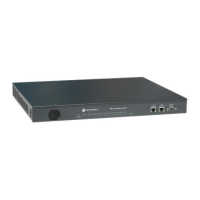RADIUS network authenticated login
Motorola, Inc. 570510-001-00 rev A Page 37 of 50
8
8
0
0
2
2
.
.
1
1
Q
Q
V
V
L
L
A
A
N
N
s
s
Note: The system requires a reboot after the “vlan enable” command. If the system is not rebooted, the webUI will
not display the VLAN configuration and the CLI will not execute VLAN commands.
V
V
L
L
A
A
N
N
S
S
p
p
e
e
c
c
i
i
f
f
i
i
c
c
a
a
t
t
i
i
o
o
n
n
VLAN modes:
IEEE 802.1Q standard compliant VLANs or Port-based VLANs on T3 Switch
IEEE 802.1Q standard compliant VLANs on WallPlates
Max number of VLANs:
128 VLANs can be created on the T3 Switch and assigned to any port. 16 total VLANs
can be assigned to interfaces on the Wireless WallPlate.
Valid VID range:
1 – 4094
Default PVID:
1
Default Egress:
transmit untagged
Default Ingress:
Accept all packets
V
V
L
L
A
A
N
N
t
t
e
e
r
r
m
m
i
i
n
n
o
o
l
l
o
o
g
g
y
y
The T3 Switch is a VLAN switch. The WallPlate is also a VLAN switch. Therefore, be certain that packets traversing
the DSL links between the T3 Switch and the WallPlate are always TAGGED.
PVID
In the 802.1Q standard, each port is assigned a PVID. This is the default VLAN ID
assigned to untagged packets received (ingress) on that port. The PVID is sometimes
called the port Native VLAN. By default, all ports are assigned VLAN 1.
Tagged
T3 will optionally tag packets when transmitting (egress) on the port. Set the port as a
tagged member of the VLAN by using the vlan membership egress command.
On the T3 Switch, the tag mode (whether a packet transmits with a tag or not) of a
packet is determined PER VLAN, not per port. This allows the T3 to support complex
VLAN configurations not possible on other switches.
On the WallPlate, the tag mode of a packet is determined PER PORT, similar to the
Cisco IOS “trunk” mode.
Untagged
T3 will optionally transmit (egress) packets without an 802.1Q VLAN tag. Use
Untagged packets on any port that is connected to a non-VLAN aware device. For
example; if a PC is connected to the WallPlate ports, packets will be untagged. This is
similar to the Cisco IOS “access” mode of a switchport.

